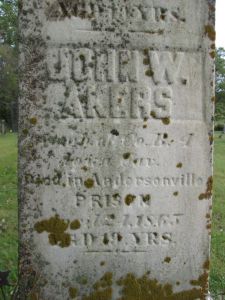Upper Bay Settlement Cemetery
It’s fall here in Iowa; the fields are browned and mostly harvested, the last russets and golds hang in the oaks and maples. The first frost occurred the other night, withering the last of the milkweed and foxtail in the ditches, and a slow stillness weaves over the heartland as we wait for the long, white slumber of winter.
Each autumn, I make a solemn visit to a nearby churchyard, the Upper Bay Settlement Cemetery (est. 1853). The grounds are tucked behind the white clapboard church which has been unused for several decades, and the tiny cemetery is mostly forgotten. A few recent graves recognize long-time family ties to the area, but it is the older section and the weathered, lichen-covered obelisk, seemingly too grand for this rural cemetery, that always draws my attention.
Iowans don’t really think much about the Civil War, and if we do, it’s more likely to be a historical footnote in the state’s memory and certainly not the revered and impassioned mythology I learned while living in North Carolina. In Raleigh, I made regular pilgrimages to the historic Oakwood Cemetery and learned the names of the Confederate dead: Anderson, Forrest, Cox, Maglenn, Walsh. Oakwood Cemetery is home to acres of Confederate gravestones and markers to indicate the battles that took the lives of those Raleigh sons and fathers. Among the rows of simple white headstones, there are towering granite obelisks to generals and memorials to the women who raised money to bring their Raleigh dead back to southern soil. The lore and romance of the Civil War is felt in every corner of Oakwood’s Confederate grounds. North Carolina, one of the original thirteen colonies, was the last of the southern states to join the war against northern aggression.
Iowa was a young state, just fifteen years into its statehood at the start of the Civil War. Then, it was mostly prairie, with scattered farms where families dug into the rich soil to survive. Small towns dotted the countryside. Here, in Delaware County, in the northeast corner of the state, they had names like Buck Creek, Hartwick, Hopkinton, and Delhi, the sleepy village I call home these days. It’s a five-minute drive along the county road, across the Maquoketa River to the Upper Bay Cemetery.
The cemetery boasts a new entrance, donated this summer, along with a steeple for the old church. A pair of wheel ruts carved into the dirt leads past the church, and a short way beyond, buffeted by cornfields, lies the cemetery. On fall days like this one, the wind whistles through the tops of the aged pine trees. Someone has mowed recently, the local scout troop I suppose, but they don’t edge among the markers, and some are nearly lost in dying weeds; others cling to the withering day lilies surrounding them. The makeshift drive ends and the cemetery faces you, at the end of a wide path down the center of the stones stands the white, weathered obelisk commemorating the local farm boys and sons of merchants who died in the Civil War.
Their names: Akers, Conners, Ward, Stanbery, Pitcher, Wilson, Nisher, most still legible 150 years later. Years ago, the obelisk was shimmed upright with a horseshoe shoved under one corner. The north face of the monument is difficult to read. A quick search through county records tells that the youngest was sixteen. The oldest, twenty-eight. One died in the battle of Pea Ridge; three men died in hospitals from their wounds. One died in the Battle of Shiloh. The Conners and Ward families lost two sons each; John Conners was just sixteen when he died in Matagorda, Texas.
But it is John W. Akers, age nineteen, who fascinates me. Carved into that soft marble beneath his name: died in Andersonville Prison, April 24, 1865.
Andersonville Prison in Macon County, Georgia. “Hell on earth” survivors called it. Disease ran rampant in the camp. Scurvy, dysentery, and hookworm killed men by the hundreds. Many starved to death, others were murdered by fellow inmates, a gang called the Andersonville Raiders who went around killing men for food, clothing, or money.
I mourn John W. Akers, the nineteen-year-old from Delaware County, Iowa, who was tossed into that hell, something no boy from these quiet and peaceful farmlands could ever imagine. I imagine his fear, being so far from home, and what he must have understood as his certain death in the filth and mire of the prison camp. A quick Internet search for photos will show men who are nothing but skin stretched over skeletons; dead but still breathing. I don’t know if he was wounded, for any wound, even in the best circumstances during the war, could be deadly, but in the prison―where only a small creek provided water that prisoners bathed in, drank from, and used as a latrine―a wound would have certainly festered and killed quickly.
There is no record of his body being returned to his family, and at the Andersonville National Memorial there are rows upon rows of markers, and I can only presume, John W. Akers was buried in the Georgia clay.
He had no way to know that the war would end just two weeks after his death.









A beautiful story, Timothy…you are a person who always sees the beauty of the desolate, a life imagined, and the voices on the wind…
Well done! I’m going to copy this for use in the museum histories of the Townships of Delaware County.
Lovely writing, a gentle tunneling into the story, which led to an unexpected and moving place.
Beautifully written ,Tim.
Enjoyed your talk and reading of this essay last nite at the Bay Cemetery Memorial Day program. I write the newsletter for a Civil War Roundtable (most members are from Black Hawk county.) Would you permit me to print your essay in a fall issue of the newsletter? I would include credit for your authorship of the essay.
Keep writing!
TIA
Very touching! I just discovered this place. My 2xG grandfather, Pvt. John Miller was one of the Civil War soldiers from Delhi who survived the war. His monument is there with his fellow patriots.. Several family members are nearby. Thanks to the Scouts for caring for the place.
I have been to Andersonville. It is heart breaking. My husband had relatives on the confederate side of the war who were also in some of the other prisons. Two did not survive. Another suffered greatly the rest of his life. Absolutely horrible! My grandson, a Living Historian, has kept vigil at Point Lookout in Maryland (another Civil War prison) where two of his ancestors had been. One died there.
Is the church still in use? Is the place still on the Registry of Historic Places?